This homemade Canadian bacon made of cured pork loin with mild maple and sage flavours eclipses any commercially available Canadian bacon I’ve ever had in my entire life.
It’s no secret that my house is a big fan of meat in general and pork specifically. Within the subset of pork, bacon of all sorts makes my guys sing with joy.
When I made homemade bacon a handful of weeks back, one of my kids walked by happily munching a strip of crispy bacon wondering aloud, “I wonder if mom could make Canadian bacon, eh?”
They followed up that statement with a quick, “That was a Canadian ‘eh’, not a Michigan one.” and then some manic giggling. Glad to see my kids are working on their regional accents.
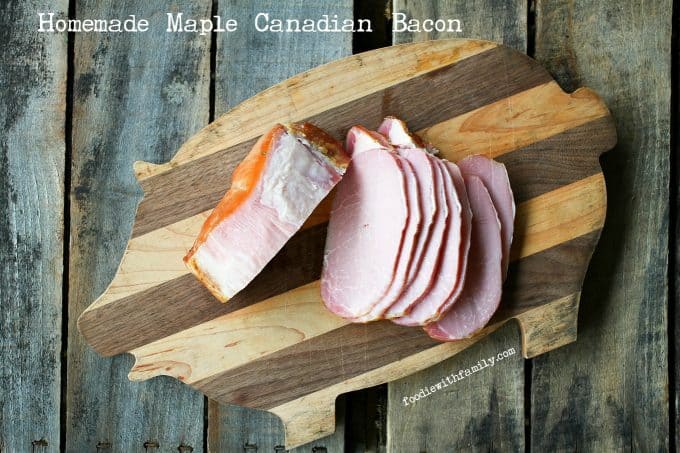
That challenge, even though it wasn’t directly delivered to me, got me to thinking. If I could make regular old American bacon, why in the world couldn’t I make some fabulous North-of-the-border bacon?
Canadian Bacon is a many splendored thing. Because it’s so lean, you really only need to heat it through rather than fry it up like our beloved American bacon making it a faster, more convenient breakfast on-the-go option.
And honestly, it’s not even really Canadian. The Canadians make pea meal bacon.
You wanna know what’s nuts? How ridiculously easy MAKING Canadian bacon is.
Mercy, though, the ease with which this is prepared pales in comparison to how insanely delicious the end product is. Cured pork loin with mild maple and sage flavours eclipses any commercially available Canadian bacon I’ve ever had in my entire life.
My unofficially official taste-testing panel of my husband and sons agreed completely. In fact, this Canadian bacon has been added to not one, not two, but THREE birthday meal requests!
What Is Canadian Bacon
The perfect Canadian bacon starts with a good chunk of readily available boneless pork loin. I’m not talking about pork tenderloins, I’m talking about center cut, lean pork loin.
Many grocers sell this in a vacuum sealed package in large amounts. This recipe makes enough brine for 4 pounds of loin, but you can upsize the brine if you get a monstrous huge loin, eh? (And I’m sorry, but that really was more of a Michigan ‘eh’ than a Canadian one…)
I feel obliged to make Canadian bacon pretty Canadian so I added a goodly slug of Grade B dark maple syrup to the brine. It gives it that something special!
If you can’t get the dark Grade B, go for a good A. The darker the syrup, the stronger the maple flavour!
If you can’t get maple syrup at all, feel free to sub in our brown sugar homemade pancake syrup. The result will be delicious if different.
Fresh sage is where it’s at, folks. Grab a bundle from the grocery store, or a handful from your neighbor’s garden (with their permission, of course!) but do splurge on the fresh sage.
And hot on the heels of my fresh sage argument, I’m going to tell you that dried whole leaf thyme is a-okay here! Fresh thyme is nice, but not quite as crucial to the finished product as the fresh sage.
Before dunking the pork loin into the brine, trim as much fat off as you can. You don’t need to be surgical, as it will be easier to remove from the Canadian Bacon AFTER it’s smoked or cooked in the oven. You can reserve the cured, smoked or roasted fat to render and add to beans.
I prefer to cut the pork loin to pieces that are a size that fit comfortably into a gallon freezer bag so they stay submerged in the brine like good little bacon.
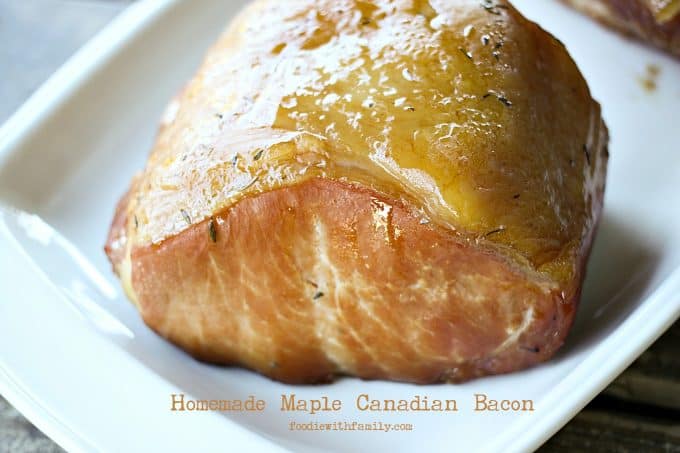
Smoking the brined Canadian Bacon over applewood is FABULOUS and preferable, but if you have no access to a smoker, you can put it in a very low temperature oven (with a little smoke box if you own one!) until the internal temperature reaches 150°F. I’ve included instructions for both methods in the recipe.
This keeps in the refrigerator for up to 10 days (courtesy of the pink salt used in the brine) but keeps far longer if tightly wrapped and stashed in the freezer.
Speaking of pink salt. I did choose to use it here.
I adapted my recipe from Michael Ruhlman’s “Charcuterie” and he makes a pretty powerful argument in favour of its use. If you choose to omit this, understand that it will shorten the shelf life in the refrigerator as well as alter the colour to more of a brown than a pink.
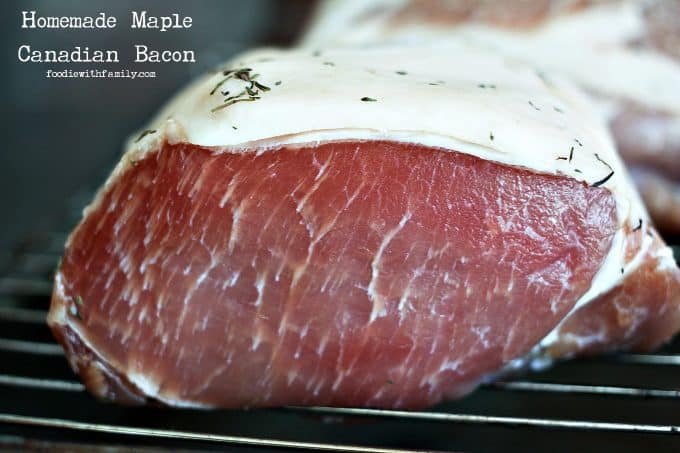
It also increases the risk of bacterial growth in the meat. Please note this means curing powder pink salts not Himalayan. The technical term for this is Prague Powder #1.
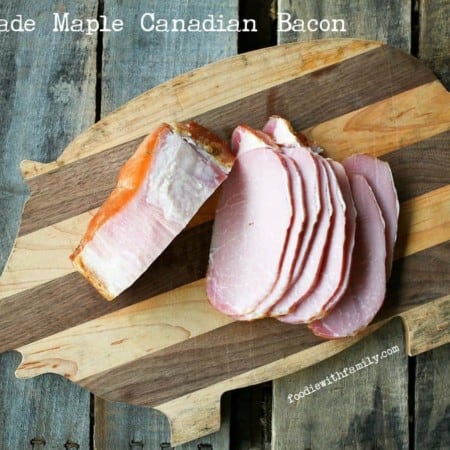
Homemade Maple Canadian Bacon {Smoker Optional}
Rate RecipeIngredients
- 1 gallon water 4 liters
- 1 1/2 cups Morton’s kosher salt 350 grams
- 1 cup raw sugar 250 grams
- 8 teaspoons pink salt 42 grams
- 1 cup Grade B Dark Maple Syrup 236 ml
- 1 bunch fresh sage
- 1 tablespoon dried thyme
- 2 garlic cloves peeled and smacked with the side of a knife to lightly crush
- 4 pounds boneless pork loin excess fat removed
Instructions
- Combine the water, salt, sugar, pink salt, maple syrup, sage, thyme, and garlic cloves in a stockpot. Bring to a simmer and stir to dissolve the sugar and salt. Remove from the heat and refrigerate until chilled all the way through. Trim the pork loin down to fit into two or more gallon sized resealable freezer bags. Insert the pork loin in the bags, then pour the cooled brine into the bags to cover the loins. Squeeze as much air as possible from the bags, then place the filled bags in a high-sided roasting pan and place the pan in the refrigerator for 72 hours.
- After 72 hours, drain the brine, rinse the pork loins, and place on a rack over a baking sheet. Put that back into the refrigerator for 24 hours to air dry.
To Smoke the Canadian Bacon:
- Hot smoke at 200°F over applewood chips for 2 to 3 hours, according to your smoker manufacturer’s instructions, or until the internal temperature of the pork loin reaches 150°F.
To Roast the Canadian Bacon:
- Preheat your oven to 200°F. Take the air-dried pork loin and put it in the oven still on its rack over its pan, and cook until the internal temperature reaches 150°F.
- Trim any remaining excess fat, then allow to cool to room temperature. Wrap the pork tightly and refrigerate for up to 10 days or wrap in a double layer of plastic wrap then a layer of foil and freeze for up to 6 months.
Nutrition
Nutritional information is an estimate and provided to you as a courtesy. You should calculate the nutritional information with the actual ingredients used in your recipe using your preferred nutrition calculator.
did you make this recipe?
Make sure to tag @foodiewithfam on Instagram and #hashtag it #foodiewithfamily so I can check it out!
Need a little help finding some Pink Salts for curing your meat? Here’s a handy-dandy Amazon affiliate link to some Prime eligible Pink Salt!
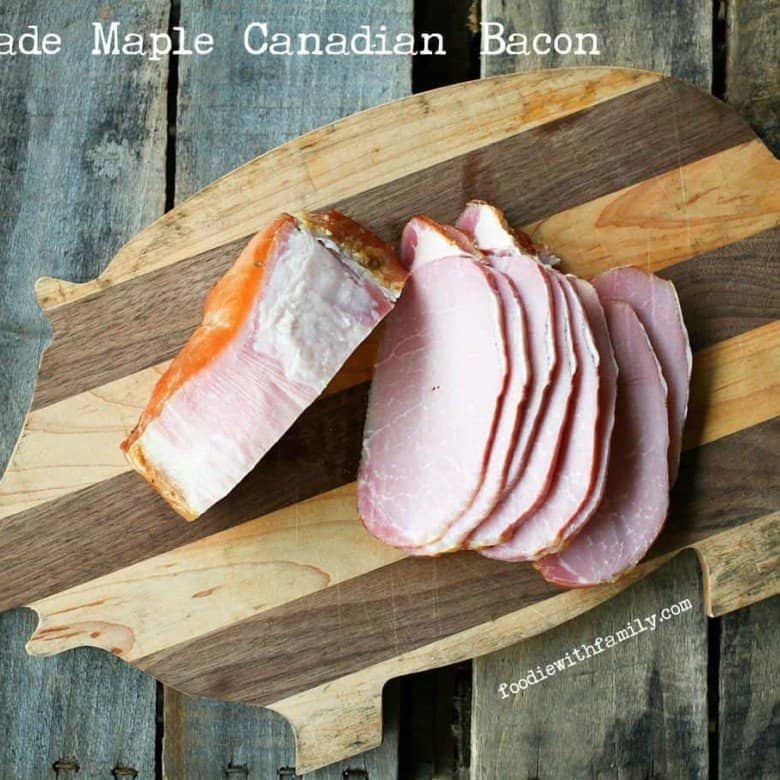



Reader's Thoughts...
Virgil Horne says
Is the bacon ready to eat after smoking or does it need to be cooked further?
Rebecca says
Hi Virgil! You definitely need to cook it further after smoking. The smoking is basically to flavour the bacon!
Mike says
No smoker. Applewood smoke flavor very appealing. Wondering if possible to use half water and half apple cider?
Complete neophyte, wanting to learn.
Rebecca says
Hi Mike- You can definitely try subbing apple cider for half of the water. If you don’t have a smoker on hand, definitely add some of the liquid smoke! Here’s an affiliate link for some liquid applewood smoke.
Christy says
Hi! I have some pork loin brining and now I’m reading that the Himalayan salt I used is not actually the same as what was intended. Oops! First time curer. Is my pork still safe for consumption?
It just won’t last as long perhaps?
Thank you!
Rebecca says
Hey there, Christy. Himalayan pink salt is a completely different critter, as you found out. I think it’ll be edible, but it won’t be a cured product. Brined pork chops sound good, though. 🙂
Sam Cope says
8 teaspoons of cure #1 is a ridiculous quantity (borderline poisonous) and about 10x more by weight in grams than you actually need for an entire pork loin. Learn how to cure meat and learn the proper ratios of salt, sugar, and cure #1. There are books. There are websites. And there is this recipe you posted which quite frankly is garbage, since I see poor people showing up in meat curing forums with a link to this recipe and wondering why it’s inedible.
Rebecca says
Hi Sam- Actually, I’m confident in keeping this recipe as is since it uses the exact ratio of pink salt called for by Michael Ruhlman and Brian Polcyn in their excellent book “Charcuterie”. It is 1 1/2 ounces/42 grams pink salt (or 8 teaspoons) to 1 gallon of water and 1 1/2 cups/350 grams Morton’s kosher salt, among other things. I can personally attest to it being quite edible as can the many people who have eaten it from this recipe.
You are, however, beyond brusque into the realm of rude. I’m sure you feel justified -rude people most often do- but I won’t let that stand here. If you’d like to try this discussion again, explaining why you think Ruhlman is wrong instead of throwing verbal punches, I’ll let you give it another shot. Otherwise, I think we’re done here.
CHEF TAFODORE says
Hi Rebecca,
As far as I’m concerned, I would have blackballed “Sam” outright. No second chances for such blatant disrespect, particularly on a public forum.
Back to the subject at hand: What I think I’m reading from these references to FDA and package-wrapper directions or measures of 1 teaspoon of pink salt to 4# or 5# of meat product is intended for sausage-type uses (recipes), where the condiment is placed directly into the mix of the meat product. Your use and measure as a brine ingredient is totally different, and much more dilute.
Rebecca says
Thanks so much, Chef! I appreciate your support and backup.
Dallas Covington says
If the recipe for the Prague (8tsp) was a rub, heck yeah it would be un-eatable…but in the brine solution, it is diluted, plus after the brining process the meat is rinsed off. take a slight sample cut, fry and see how it tastes. if too salty for you, keep in a container of water for another 45 minutes to leach out a bit more of the saltiness. try again. (TAAT= Taste, Analyze, Adjust, Taste) a tip from my chef engrained in us. :o). Later!
Leo Lajeunesse says
I would say for your Peameal Bacon 8 teaspoons of Pink Salt #1 is not right for 4 lbs of meat, manufacture of pink salt : 1 teaspoon per 5 lbs of meat.
Rebecca says
Hi Leo- Actually, I’m confident in keeping this recipe as is since it uses the exact ratio of pink salt called for by Michael Ruhlman in his excellent book “Charcuterie”. It is 1 1/2 ounces/42 grams pink salt (or 8 teaspoons) to 1 gallon of water and 1 1/2 cups/350 grams Morton’s kosher salt, among other things.
Matt says
WORD OF CAUTION!!!!
Nice recipe and I followed most of it but I feel I must warn everyone here. You should use at most 1 (level) teaspoon of pink salt (prague powder #1). 1 level teaspoon will do 5lbs of meat. You have 8 teaspoons listed which is WAY too much to the point of possibly causing health problems. Pink salt is toxic and has to be measured accurately.
If you are referring to something other than prague powder #1 or insta cure #1 please specify and update the recipe.
Besides that it looks great and I’m looking forward to smoke mine in another day….
Rebecca says
Hi Matt- Actually, I’m confident in keeping this recipe as is since it uses the exact ratio of pink salt called for by Michael Ruhlman in his excellent book “Charcuterie”. It is 1 1/2 ounces/42 grams pink salt (or 8 teaspoons) to 1 gallon of water and 1 1/2 cups/350 grams Morton’s kosher salt, among other things.
Billy Reid says
I lived in Refugio, Texas. I started getting ingredients , bought a nice loin, got apple wood pellets for my Traeger grill, got my fresh herbs, and was preparing the brine, when we received notice to vacate immediately. Well hurricane
Harvey came along about that time and took everything.
I haven’t had the nerve to try again but it still sounds good. Will try again soon.
Rebecca says
I’m glad you’re safe! I hope you are settling back in well. 🙂
Anne says
If not using pink salt, do you increase the other salt?
Thanks for the information.
Steve says
Your write up says to leave in brine for 72 hrs yet the book you quoted from says 48 hrs.just wondering why you changed time.
Rebecca says
Hi Steve- Confession time. The reason I increased the time was purely accidental. I left it in the brine longer than specified and ended up liking the results so much that I listed it that way in my recipe. 😀
Marsha Ferris says
How many sprigs or ounces of sage is in a bunch?
Rebecca says
3 or 4, give or take. It’s really not a hard and fast number.
Sonya Lang says
someone made a comment about the amount of pink salt. Just a word of caution. There are a variety of nitrate preparations on the market. Make sure you read the label on the one you purchased and use the amount indicated. I have bought something at a butcher supply store that is called super cure. I only use 1.8-3g/Kg of meat, that is not a lot, not hardly a teaspoon. So whatever recipe I use, I calculate the amount of super cure that I need based on the ratios it lists on the package, then I proceed with the recipe. Also on the note of nitrates, I have read a lot about it and from what I can tell, the biggest contribution to most peoples diets is from the nitrate that naturally occurs in their tap water. Compared to celery seed extract, when you measure out commercial nitrates, you know what you are getting, using the celery preparations you cannot be sure of the final concentration and cannot therefore be certain that you are preventing bacterial growth. You may also be getting nitrate levels way higher than any commercial preparation may give you. Life is a world of chemicals, naturally occurring and man made, not all natural things are beneficial, and not all man made things are bad for you. And by the way, this Homemade Canadian Bacon is really great and that is what it is all about. We have decided that using a pork loin this way is something that we prefer to roasting it all. We prefer the versatility in using the bacon up this way, rather than just roast pork leftovers, breakfast sandwiches, alongside pancakes or waffles, or cut up in them, sub for ham in western omelettes, use in Chinese stir fry instead of BBQ pork, use in homemade or store bought pork and beans, cube it up into lentil or split pea soup, warmed up and served with mustard in a sandwich, the list goes on!.
Alex says
Hi Rebecca,
Im wondering if the cut Im using is only 3 lbs i should adjust the quantities for the brine or not?
Thank you.
Andy Rozbicki says
Here’s from a recent graduate (me) from a weekend sausage making and meat smoking seminar. I can try to lay out the points on the pink salt. In the USA the meat industry is regulated by the FDA. The Sodium Nitrite (NOT Nitrate) must be dyed to differentiate it from regular salt so the industry has decided to dye it pink. This stuff goes by names like Prague powder #1, Instacure #1. It is is 93.75% salt and 6.25% Sodium Nitrite. Reason they do this because for a sausage recipe you only put in about 1/4 teaspoon or roughly 4 grams of this pink salt into a pound of meat to cure it and for it to be within FDA safe limits for human consumption. If you used pure sodium nitrite you would not be able to accurately measure it for small quantities of meat.
Now in Canada there is no law that states mandatory dying of of Instacure. All the curing salts are white. In Edmonton (Canada) we are fortunate to have at least 3 butcher supply places that have this on the shelf (Halfords, Butchers and Packers, High Calibre, google them for more info). As a final thought there are more curing mixes out there. You will see stuff like general cure, FS cure. There are NOT 6.25% sodium Nitrite. You will have to adjust your amount of cure per pound of meat to be within safe limits for smoking meats. Remember you only smoke the loin until 150F internal temperature. The FDA safe limits for cooking meat is to be above 162F internal temperature to kill off botulism. The curing salts have a natural botulism killer in them. A hundred years ago there was no fridges, you needed curing salts to extend the shelf like. Now it is purely symbolic. That’s why a chunk of pork loin smoked without curing salts is white and one that is cured is pink. It all has to do do with the chemical interaction with the hemoglobin in the meat.
Jamie Worrell says
Could you substitute Tender Qwuick for pink salt??
Rebecca says
I honestly would hesitate, Jamie, because I don’t know whether they’re equivalent. If you can find a reliable source that says they are, I’d say go for it, otherwise, I’d order the pink salt!
Lorrie says
Absolutely different. Himalayan pink salt has no sodium nitrite and is not for curing.
Marsha Ferris says
From other sites on making this, don’t substitute the salt, one idea of the pink is, the meat gets a pink tint inside as opposed to grey in color, presentation. Non of the sites recommend substituting.
Ellen Renee says
Storage question for you…I am preparing to make this for the first time soon and wanted to check about this…have a small family and will be freezing most of it. Do you slice all of it and freeze that way or freeze it whole and slice when defrosted?
Rebecca says
Hi Ellen, Excellent question. My personal preference is to freeze it in blocks and then thaw and slice. The reasoning (at least as I see it) is that the more intact something is going into the freezer, the better it will hold up over time. Not that it gets to stay in my freezer for too long, but I feel like it is less likely to suffer freezer burn when frozen properly in the large pieces.
Gilian says
I started a 2.5 piece of pork loin on Monday and I Finished it yesterday, Thursday. I used lots of fresh cracked black pepper, some garlic and some vanilla along with the other necessary ingredients. Someone asked if they could use liquid smoke. Because I was too lazy to take out my smoker, I used 1 tsp of liquid smoke which was added to my brine in which I only used a half gallon of water. I came out perfect, best tasting smoke flavored piece of bacon I have ever tasted. I will never buy store bought again. It was so tender and juicy. The absolute best.
jeff says
looks amazing and sounds great! do you know if you can you substitute tender quick for the pink salt? if so, any idea on amount?
Rebecca says
Hi Jeff- Theoretically I’m sure you can, but I’m not familiar with the equivalent amounts of Tender Quick and Pink Salt. If you have a good meat shop nearby who makes their own bacon, they might be a good resource! I’d love to know what you find out, though!
Bryan says
and would this brine work on pork belly to.
Rebecca says
Do you mean to make a standard bacon? I imagine so but haven’t tested it and so can’t vouch for the potential results.
Bryan says
Hi Rebecca,
I Just want to make sure you use 8 teaspoons pink salt. That seems like a lot for 4# of meat. Thanks
Rebecca says
I use the same ratio of pounds of meat to pink salt as specified in Michael Ruhlman’s charcuterie in his Canadian Bacon recipe.
Ed says
I would like to know what type of pink salt you used? I used #2 Prague powder from my local butcher & followed the recipe exactly. The bacon turned out extremely salty to the point of beinng inedible. Second batch used only 3/4 cup kosher salt and 1 tsp #2 Prague powder (pink salt) and it turned out perfect! Also basted with a 50\50 maple syrup & Canadian whiskey blend every 30 min incredibly tasty!!!
Rebecca says
Whoa! That maple syrup whiskey combo sounds amazing! I used
… It’s my understanding that not all pink salts are the same. There is Prague #2 and Prague #1 among others!